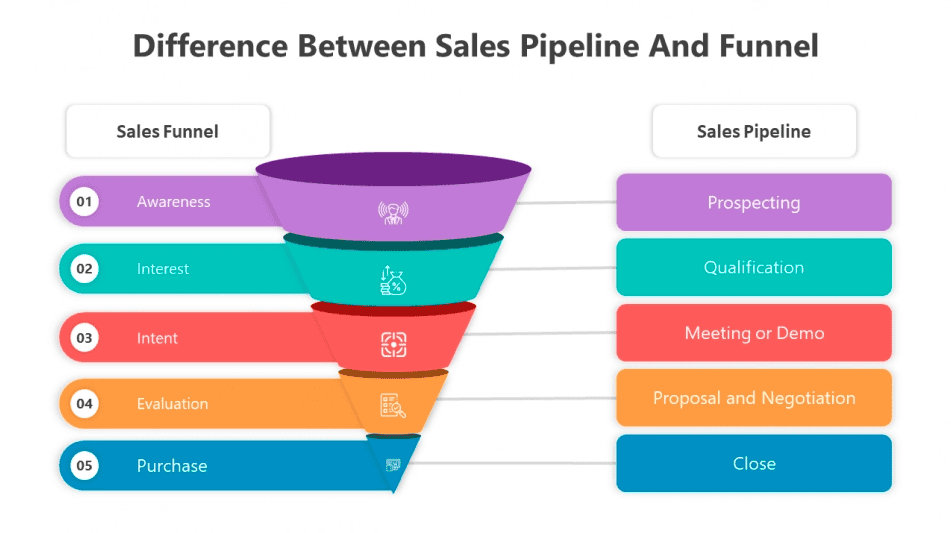

A sales pipeline is more than just a buzzword; it’s the visual and strategic representation of the sales process from the first interaction with a potential lead to closing a deal with a customer.
Visualizing your sales pipeline can prove incredibly beneficial. It’s about laying out each step that a prospect takes, transforming them from a potential lead into a loyal customer. This visualization not only helps you track progress but also reveals the health of your sales processes at a glance. Keep reading as we delve into the vital relationship between the sales pipeline, leads, customers, and the journey they embark on during the purchasing process.
The Role of a Sales Pipeline in Business Development
The sales pipeline is a vital framework that captures the essence of business growth and revenue generation. By understanding its role, companies can better grasp how to foster development and accelerate their path to success.
Connecting Your Sales Pipeline with Business Growth and Revenue
The analogy of a pipeline effectively illustrates the flow of potential deals from initial contact to closing. Each section of the pipeline represents a step in the sales process, filled with opportunities that, when properly managed, lead to consistent business growth and increased revenue. By nurturing leads at each stage, businesses ensure a steady stream of income.
Understanding the Link Between Your Sales Pipeline and Company Product and Service Offerings
Every product or service has a lifecycle, and the sales pipeline mirrors this journey. From the introduction of a new offer to the growth, maturity, and eventually decline, the sales pipeline manages prospects at different stages, aligning sales strategies with the lifecycle stage to maximize longevity and profitability.
- In the introduction phase, the pipeline is focused on creating awareness and capturing early adopters.
- During growth, efforts shift to riding the upward trajectory and outpacing competitors.
- Maturity calls for strategies to maintain position and prepare for eventual renewal or reinvention.
- Finally, in decline, the pipeline helps manage diminishing returns and strategize for product/service exits or revamps.
Stages of a Sales Pipeline
Understanding the key stages of a sales pipeline can dramatically improve your engagement and success rates in sales. Each phase represents a milestone in the journey from prospect to satisfied customer and, if managed well, sets the foundation for future business.
Here’s a breakdown of the typical stages of the sales pipeline:
Stage 1. Lead Generation
The first stage is all about identifying potential customers who might be interested in your product or service. Employ targeted marketing tactics to entice and secure leads. A few of the most impactful ways companies can generate leads include:
- Cold calling
- Email marketing
- Content marketing
- Search engine optimization (SEO)
- Social media marketing
- Paid search advertising
This stage serves as the foundation, focusing on engaging potential customers intrigued by your offerings, and setting the groundwork for the different stages of the sales process.
Want a look into the top B2B lead generation strategies and how to approach them for maximum impact? Read our blog here for insight straight from our lead generation experts.
Stage 2. Initial Contact
Once a lead is generated, the next step is to make contact. Reach out via email, phone, or in-person interaction to present your product or service. Here, you’ll also confirm who the decision-maker is for the prospective business, ensuring you build a relationship with someone who has buying power. This step aims to establish communication and nurture the lead into a potential customer through personalized engagement and tailored pitches.
Stage 3. Qualification
Not every lead is a good fit. In the qualification phase, scrutinize if the prospect genuinely requires your product, possesses the financial capacity, and if the timing aligns with their purchasing readiness. This assessment ensures resources are directed towards promising opportunities, enhancing efficiency, and maximizing sales potential.
Stage 4. Nurturing
The lead nurturing stage entails fostering relationships with potential customers through tailored communication and valuable content. It aims to build trust, address concerns, and guide leads through the decision-making process, ultimately converting them into loyal customers by providing continuous support and relevant information.
Stage 5. Proposal/Presentation
Qualified leads receive personalized value propositions tailored to their unique needs. Craft proposals or presentations that address their concerns directly, demonstrating how your offering solves their problems. By aligning with their requirements, you enhance the likelihood of conversion, foster trust, and strengthen your position in the sales process.
Stage 6. Closing the Deal
This stage is where negotiations take place, objections are handled, and the final sale is made. Your goal is to make the benefits of your solution so clear that the prospect turns into a customer.
Step 7. Post-sale
After the sale, the journey isn’t over. Providing excellent post-sale support and follow-up can lead to customer retention, referrals, and additional sales in the future.
It’s worth noting that while these stages represent a common sales pipeline, they should be adjusted based on your specific business model or the products and services you offer. Some businesses might have a longer nurturing phase, while others might combine stages depending on the complexity of the sale or the buyer’s journey.
Don’t have time to run a sustainable sales pipeline? Abstrakt’s lead generation services empower growing B2B businesses to spend more time selling and less time looking for their next big sales opportunity.

Understanding the Role of a Sales Pipeline in the Sales Process
The notion of a sales pipeline is more than just a visual representation of sales prospects. It’s the backbone of a successful sales strategy.
Each stage of the sales pipeline adds structure and clarity to the journey a potential customer takes, from initial contact to closing the deal. By breaking down the process into distinct phases, sales teams can more easily manage individual leads and avoid bottlenecks that may hinder progress.
Tracking Momentum and Progress
A sales pipeline provides a transparent overview of where prospects are in the sales cycle. It serves as a crucial tool for tracking progress and maintaining the momentum of sales activities, allowing teams to adjust their approach as needed and ensure that no opportunity is overlooked.
Forecasting and Strategic Insight
The sales pipeline’s data is invaluable for forecasting future sales and setting realistic revenue goals. It informs strategy by revealing trends and patterns related to the success—or failure—of sales initiatives. Better forecasting leads to more informed decision-making and resource allocation, ensuring that efforts are focused on the most promising opportunities.
As we can see, a sales pipeline is more than just a tool—it’s a strategic asset that informs every aspect of the sales process, from planning to execution. By fully understanding the importance of a sales pipeline, businesses can optimize their sales efforts and drive sustainable growth.
How to Build a Sales Pipeline
Creating a robust sales pipeline is like building the foundation of your sales architecture. It involves strategic planning and consistent effort to guide potential customers through various stages of the buying process.
Identify Your Target Market and Ideal Customer Profile
The first step to building an effective sales pipeline is identifying your target market and understanding who your ideal customer is. This requires market research, analysis of current customer data, and a keen understanding of who benefits most from your products or services. By crafting an ideal customer profile, you can tailor your sales and marketing efforts to attract the most valuable leads.
Determine Your Ideal Lead Generation Strategies & Their Impact on the Sales Pipeline
Once you know who your ideal customer is, you need to deploy effective lead generation strategies. From content marketing, networking events, and social media campaigns to cold outreach, the possibilities are vast. The key is to choose strategies that align with where your ideal customers are most active and engage them with valuable solutions to their pain points.
Effective Approaches to Move Leads Through the Pipeline Stages
Advancing leads through the pipeline requires a clear understanding of the sales process and personalized communication. To move a lead from awareness to decision-making, consider the following approaches:
- Engage with leads promptly to establish trust and rapport.
- Provide educational content that addresses common questions and objections.
- Offer product demonstrations or free trials to showcase your solution’s value.
- Maintain regular follow-ups to keep leads engaged and informed.
- Utilize a customer relationship management system to track interactions and progress.
With an efficient sales pipeline build, you can get more sales meetings with qualified prospects. Explore other ways to get more (and better) B2B sales appointments here.
Sales Pipeline Management Best Practices
Adhering to a set of best practices for managing your sales pipeline is crucial to ensuring it remains a reliable blueprint for your sales activities. These best practices are designed to optimize the functionality, clarity, and impact of your sales pipeline on your business’s bottom line.
Regular Review and Updating of the Pipeline
Regular reviews are essential to keep your pipeline current and reflective of the actual sales landscape. This involves removing stale opportunities, updating the progress of ongoing deals, and forecasting future sales with the most up-to-date information available.
Ensuring Data Accuracy and Consistency
The integrity of your sales pipeline hinges on data accuracy and consistency. This means all information should be meticulously recorded and standardized across the pipeline to prevent misinterpretations and errors that could lead to misguided decisions.
Training Sales Teams to Effectively Navigate and Utilize the Pipeline
An effective sales pipeline is only as good as the team that uses it. Providing comprehensive training to your sales staff on how to manage the pipeline will empower them to forecast more accurately, identify opportunities more swiftly, and ultimately close more deals.
- Conduct regular pipeline review sessions with the entire sales team.
- Exercise vigilance in maintaining data quality within the CRM tool.
- Instill a culture of accountability where each team member understands their role in pipeline management.
- Encourage the adoption of a shared language for pipeline stages and status updates to ensure seamless communication among team members.
Best Tools and Software to Optimize Sales Pipeline Management
Managing a sales pipeline effectively requires the right tools and software tailored to enhance visibility and control throughout the sales process. Embracing technological solutions not only helps streamline the stages of your sales pipeline but also provides invaluable insights that can propel your business to greater heights.
CRM Systems: The Backbone of Sales Pipeline Management
At the core of sales pipeline management is Customer Relationship Management (CRM) software. CRMs serve as the central hub for tracking interactions, managing contacts, and monitoring deal progression. The functionality of these systems is crucial for maintaining up-to-date information on prospects and ensuring that no opportunity slips through the cracks.
Top Software That Revolutionizes Pipeline Management
- Salesforce: A powerhouse in CRMs, Salesforce offers comprehensive features that cover every aspect of sales pipeline management.
- HubSpot Sales: Known for its user-friendly interface, HubSpot facilitates seamless sales activities with its all-in-one suite of tools.
- Zoho CRM: Zoho caters to businesses of all sizes with its scalable platform and robust automation capabilities.
- Pipedrive: As its name suggests, Pipedrive focuses on pipeline management, making it a favorite for sales teams that prioritize visually driven sales processes.
Enhancing Efficiency Through Integrations
The ability to integrate with other business systems is not just convenient—it’s expected. CRM systems and sales tools often come with built-in integrations for marketing automation platforms, email tracking solutions, and even project management software. These connections ensure a seamless flow of information across departments and tools, providing a complete view of the customer lifecycle and enabling data-driven decisions.
By leveraging the right tools and software for sales pipeline management, businesses can ensure that their sales teams are equipped to convert leads into customers more efficiently. Enhanced organization, improved communication, and access to analytical insights are just a few of the benefits that modern sales tools bring to the table.
Learn about the most important tools you should use for B2B lead generation here.
Core Metrics to Measure Sales Pipeline Performance
Understanding what is a sales pipeline involves more than just defining it. To truly grasp its effectiveness, you need to measure its performance meticulously. Regularly analyzing key performance indicators (KPIs) ensures the health of your pipeline and can be the difference between mediocre outcomes and achieving exceptional sales targets.
Key Performance Indicators for Evaluating Pipeline Health
Metrics play a pivotal role in assessing the health of your sales pipeline. They enable sales managers to make data-driven decisions and provide insights into where your pipeline is thriving and where it requires attention. Paying attention to these KPIs could mean the difference between a faltering sales process and a robust revenue stream.
- Lead conversion rates reflect the percentage of leads that have become actual sales. A lower-than-expected conversion rate might signify issues in the earlier stages of your pipeline, whereas higher rates suggest your sales tactics are working smoothly.
- Deal velocity measures the average time it takes for a lead to go from initial contact to closing. A slow velocity could indicate bottlenecks, prompting you to address inefficiencies that could be stalling potential deals.
Identifying Bottlenecks and Areas for Improvement
By monitoring these and other pertinent metrics, such as the average deal size and sales cycle length, you can more accurately diagnose problems. These insights empower sales teams to concentrate their efforts on fine-tuning their strategies, ultimately enhancing pipeline performance and boosting sales outcomes.
- Analyze customer drop-off points to identify stages that may require a more refined approach.
- Use lead conversion rates to gauge the effectiveness of your lead qualification criteria.
- Keep an eye on deal velocity to ensure there are no unnecessary delays in your process.
Investing time in analyzing these metrics will allow your business to stay proactive and ahead of potential issues within your sales pipeline, ensuring ongoing growth and success.
Common Challenges in Sales Pipeline Management
Every sales organization faces obstacles that can hinder the effectiveness of their sales pipeline. Recognizing these challenges is the first step to ensuring a smooth sales process and achieving desired results.
Identifying Common Obstacles in Managing a Sales Pipeline
Managing a sales pipeline involves multiple moving parts and requires consistent attention to detail. Among the typical hurdles are:
- Inaccurate or incomplete data can lead to misinformed decisions.
- Poor communication between sales and marketing teams affects lead quality and follow-up.
- Difficulty in prioritizing prospects or opportunities effectively.
- Challenges in forecasting sales due to an inconsistent pipeline.
Strategies to Overcome Pipeline Management Issues
Overcoming these issues requires a proactive approach:
- Implement a standardized process for follow-ups and use a shared calendar or scheduling tool to ensure no lead is left untouched.
- Leverage lead scoring and pipeline analytics to highlight high-priority leads and minimize the chances of them slipping through the cracks.
Maintaining a Balanced Pipeline with Prospects at Various Stages
A well-balanced pipeline is crucial for steady revenue flow. Here’s how sales teams can maintain equilibrium:
- Continuously replenish your pipeline with new leads to avoid dry spells.
- Monitor the progress of deals and nurture prospects at each stage to ensure a consistent transition down the pipeline.
- Use historical data to predict and mitigate bottlenecks before they become problematic.
While challenges in sales pipeline management are inevitable, they can be mitigated with a strategic approach and consistent execution of best practices. Addressing these common issues not only smoothens your sales process but also maximizes your pipeline’s potential for success.
Sales pipeline management can only be as strong as your understanding of the B2B lead generation and marketing funnel. Read our blog here to check out the different stages of the marketing funnel, and how to meet prospects with where they’re at in the buying process.
Best Strategies to Enhance Sales Pipeline Efficiency
Ensuring your sales pipeline performs at its best is pivotal for the growth and success of any sales-driven organization. Implementing effective strategies to optimize your sales pipeline can dramatically improve your sales outcomes.
Techniques for Maintaining a Healthy Pipeline Flow
- Regularly qualify leads: Constantly review and ensure that only prospects with a high likelihood of conversion are in your pipeline.
- Focus on lead nurturing: Develop relationships with potential clients through consistent, tailored communication.
- Measure pipeline metrics: Monitor key performance indicators to spot and rectify bottlenecks in your pipeline.
Automation and Tools That Streamline the Sales Process
- CRM systems: Leverage CRM tools to automate data entry and lead tracking.
- Email automation: Use automated email sequences to stay in touch with prospects efficiently.
- Sales intelligence software: Implement advanced tools that provide insights into prospect behaviors and preferences.
Aligning Sales and Marketing Efforts for Better Pipeline Outcomes
- Collaborative goal setting: Ensure that both your sales and marketing teams work toward shared objectives.
- Content alignment: Use marketing content that addresses the specific needs of leads at different stages of the sales pipeline.
- Feedback loops: Create mechanisms for regular feedback between sales and marketing to refine strategies and messaging continuously.
Taking a systematic approach to improving your sales pipeline efficiency not only accelerates the conversion process but also enhances the overall performance of your sales team. By focusing on the alignment of sales and marketing, utilizing the best automation tools, and adhering to proven techniques, you can ensure that your sales pipeline remains robust and effective.
The Role of CRM in Sales Pipeline Management
Every successful sales operation hinges on precise management and clear visibility of its sales pipeline. CRM systems have become instrumental in achieving these objectives. CRM tools offer a centralized platform to track all sales interactions and processes, ensuring that opportunities are captured and leads are nurtured effectively throughout the sales pipeline.
Empowering Sales Pipeline Visibility and Control
A robust CRM system provides real-time insights into each stage of the sales pipeline. Sales teams can readily identify bottlenecks, monitor progress, and make data-driven decisions to push deals forward. By improving visibility, CRMs ensure a seamless flow of information that empowers sales managers to implement strategies that align with the movement of leads through the pipeline.
CRM Features that Enhance Lead Management and Deal Closure
- Lead Scoring: CRMs help in qualifying leads by scoring them based on their actions and engagement level, allowing sales reps to focus on prospects with the highest potential for conversion.
- Contact Management: CRMs maintain a database of customer interactions, enabling personalization and timely follow-ups, which are essential for nurturing leads and closing deals.
- Workflow Automation: Automating repetitive tasks saves time and ensures that no lead is left behind due to manual errors or oversights.
- Reporting and Analytics: CRMs’ data-driven insights assist in forecasting and performance monitoring, leading to better strategy formulation and resource allocation.
CRM integration has become non-negotiable in today’s competitive sales environment. With its ability to streamline the sales process and provide valuable insights, a CRM is the backbone of effective sales pipeline management, helping businesses close more deals and build lasting relationships with their customers.
Sales Pipeline vs. Sales Funnel: Understanding the Differences
Often used interchangeably in the sales industry, the terms sales pipeline and sales funnel actually refer to two distinct concepts that play a crucial role in understanding customer interactions and steering the sales process. Grasping the nuances between them can enhance your strategic approach to sales and marketing.
The sales pipeline illustrates the steps a sales team takes to move a prospect from the initial contact to the closing of the deal. On the other hand, the sales funnel offers a visual depiction of the customer’s journey, mapping the reduction of prospects as they pass through various stages, from awareness to purchase, from the customer’s viewpoint.
While a sales pipeline helps sales teams monitor and manage their engagements with potential customers, the sales funnel provides valuable insights into the rate at which prospects are converted to customers, highlighting potential bottlenecks in the customer acquisition process.
Creating and building a sales pipeline is typically the role of sales departments. However, moving decision-makers down the sales funnel is more of a marketing function, creating quality content that aligns with what people buyers are looking for at their stage in the buying cycle. Coordination between sales and marketing teams helps align business growth goals and how they intend to move potential buyers from one stage to the next.
How Each Model Serves Distinct Strategic Purposes in Sales and Marketing
For sales managers, a pipeline view is instrumental in forecasting sales and managing the team’s activities to ensure that sales targets are met. It is critical for resource allocation, and managing individual and team performance. Meanwhile, marketers greatly benefit from a funnel perspective to understand market behavior, optimize marketing efforts, and increase conversion rates at different stages of the customer journey. Thus, both models work in tandem—while the sales pipeline drives operational efficiency, the sales funnel hones marketing tactics.
- Sales Pipeline: Focuses on sales actions, and deal progression, and is used to track the efficiency of the sales processes.
- Sales Funnel: This funnel concentrates on the customer’s journey, identifies conversion rates, and helps pinpoint losses in customer interest.
Understanding the differences and strategic applications of the sales pipeline and the sales funnel empowers businesses to tailor their customer acquisition and retention strategies more effectively and clearly define the path from potential lead to loyal customer.
For a complete look into the differences between a sales funnel and sales pipeline, read our blog here.
Fuel Your Sales Pipeline With Lead Generation
Lead generation is the driving force behind the momentum of your sales pipeline. Like the blood that pumps through the veins of your sales process, leads are the lifeblood of a thriving business. Without an effective strategy to attract and engage potential customers, the pipeline can quickly become stagnant. Understanding lead generation’s pivotal role ensures that the pipeline remains filled with high-caliber prospects eager to move forward in the sales journey.
Effective Lead Generation Methods
Building a strong pipeline starts with identifying and implementing effective lead generation strategies. These methods range from inbound marketing efforts, like content marketing and SEO, to outbound techniques, such as cold emailing and telemarketing. The key lies in determining which channels yield the most engagement and conversion for your particular business model and audience.
- Cold Calling
- Email Marketing Campaigns
- Content Marketing
- Search Engine Optimization (SEO)
- Pay-Per-Click (PPC) Advertising
- Social Media Advertising
- Networking Events and Webinars
Techniques for Nurturing Leads to Become Sales-Ready Prospects
To capitalize on the generated leads, companies must nurture them effectively. This nurturing process delicately guides potential customers through the pipeline, providing them with the information and attention they need to become sales-ready prospects. Techniques such as personalized email sequences, targeted content offers, and value-driven engagement can be used to build relationships and trust with leads.
- Segmentation and Personalized Email Campaigns
- Educational Content and Thought Leadership
- Exclusive Offers and Demonstrations
- Regular Follow-ups and Check-ins
- Customer Success Stories and Testimonials
Qualifying Prospects in the Sales Pipeline
Understanding who your ideal prospects are plays a pivotal role in maintaining a robust and efficient sales pipeline. Qualifying prospects is a critical step in ensuring that your sales efforts are not wasted on leads unlikely to convert, allowing your sales team to focus on leads with the highest potential for closure. Let’s delve into the essential criteria for prospect qualification, the tools that can aid this process, and the overarching importance of qualification in building a healthy sales pipeline.
Criteria for Prospect Qualification
Properly qualifying prospects ensures that the sales team focuses on leads with a genuine interest and the means to purchase. Here are key criteria to consider:
- Need: Does the prospect have a need that your product or service can address?
- Budget: Does the prospect have the budget or financial resources to make a purchase?
- Authority: Is the contact person authorized to make buying decisions?
- Timing: Is there a sense of urgency or a suitable timeline for making a purchase?
Tools and Techniques for Assessing Prospect Potential
To evaluate a lead’s qualification status, sales teams may employ various tools and techniques, such as:
- CRM Software: Centralize customer data and track interactions to gauge interest level and purchasing power.
- Lead Scoring Systems: Assign numerical values to leads based on how they match your qualification criteria.
- Needs Assessment: Engage in conversations or surveys to better understand the prospect’s business needs and challenges.
The Importance of Qualification in Maintaining a Healthy Pipeline
Failure to qualify leads can lead to a bloated and ineffective sales pipeline, causing wasted effort and resources. By establishing clear qualification criteria and utilizing effective assessment tools, sales teams can streamline their pipeline. This ensures that each prospect in the sales pipeline has a higher chance of progressing through to a closed deal, thus maintaining momentum and improving overall sales performance.
Forecasting Sales Through Pipeline Analysis
Understanding how your sales pipeline can predict future success is crucial for businesses looking to solidify their strategy and set realistic goals. By examining your past and current sales pipeline data, you’re able to make informed predictions about upcoming sales performances. This forecasting becomes the foundation for strategic decision-making and helps in aligning sales efforts with company objectives.
Utilizing Pipeline Data for Forward-Looking Insights
Analyzing the flow of deals through the pipeline allows businesses to identify patterns and trends that can help forecast future sales with a higher degree of accuracy. Knowing how many leads enter the top of the funnel and the percentage that converts to actual sales can inform not only your sales targets but also highlight potential areas for improvement.
How Forecasting Informs Sales Strategy and Goal Setting
Effective sales forecasting enables businesses to set realistic targets and tailor their strategies accordingly. It can also help in resource allocation, such as determining whether more staff are needed, whether additional training is required, or whether adjustments need to be made to sales processes.
- Resource Allocation: By predicting busy periods or potential sales slumps, companies can better manage staffing needs and budget allocation.
- Strategy Adjustment: Sales forecasts can indicate when a change in approach is necessary to meet targets or take advantage of emerging trends.
- Performance Tracking: Regular forecasting lets businesses track their performance against projections, offering visibility on whether strategic changes are yielding the desired outcomes.
Sales forecasting is not only about predicting the future; it’s about creating a dynamic, informed sales strategy that evolves with your pipeline’s performance. The clearer the picture that your sales pipeline analysis provides, the more confident you can be in your business’s direction and decisions.
Sales Pipeline Conversion Rates and How to Improve Them
Understanding and improving conversion rates within your sales pipeline is crucial for increasing efficiency and driving revenue growth. Each stage of the sales pipeline offers unique challenges and opportunities for enhancement. Let’s dive into actionable tactics that can help you convert more leads into paying customers.
Understanding Conversion Rates at Different Pipeline Stages
Conversion rates vary widely between different stages of the sales pipeline. Analyzing these rates is essential to identifying bottlenecks or stages that require optimization. A thorough analysis can highlight patterns and trends, allowing for a strategic approach to improvements.
Tactics to Enhance Conversion Rates
- Personalized Communication: Tailor your communication to the specific needs and interests of each prospect. Personalization can significantly increase the likelihood of advancing a lead to the next stage.
- Value Demonstration: Clearly demonstrate the value your product or service provides. Use case studies, testimonials, and data to reinforce how you can solve the prospect’s pain points.
Continuous Improvement Through Testing and Sales Team Training
Investing in sales team training will ensure your representatives have the skills and knowledge necessary to move leads through the pipeline effectively, ultimately boosting conversion rates and maximizing sales potential.
Key Takeaways
Building and maintaining a sales pipeline is crucial for effective business development. Without the proper actions in place, you put your pipeline at risk, resulting in few quality leads generated. However, this can be costly and time-consuming if done internally. But we’re here to take the pressure off your back.
Abstrakt Marketing Group is a nationally recognized B2B lead generation company that empowers growing businesses like yours to fill their sales pipeline with qualified prospects and ready-to-buy leads through sales appointment setting and search engine marketing.
When you’re ready to put your sales pipeline management efforts into the hands of experts, contact the business development reps at Abstrakt!





